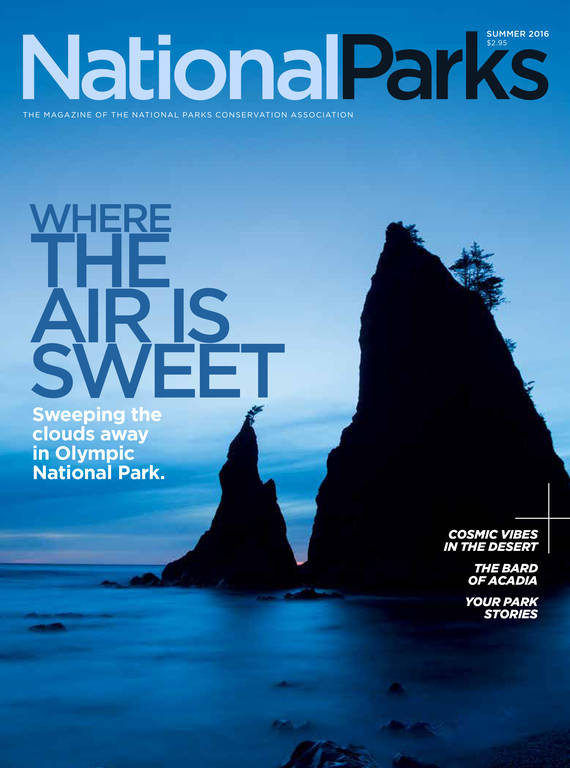Summer 2016
Surround Sound
The Acoustic Atlas’ trove of recordings includes grizzly cubs purring, ice freezing and thousands of other elusive sounds.
What sound does a frog make? If you say ribbit! you would be right. And wrong. Ribbit is the sound of a Pacific chorus frog (also called Pacific tree frog), and because that species is abundant on the West Coast, Hollywood sound technicians turned to it when they needed frog noises for movie and television soundtracks. And so for most people, that has become the de facto frog sound. But ribbit is just one of the many sounds various frog species make, as Jeff Rice will tell you. He would know. A longtime frog aficionado with a frog ringtone to prove it, Rice has recorded many of these sounds himself, including the classic ribbits of the Pacific chorus frog in Olympic National Park:
Unlike Rice, most of us have lost our connection to pure natural sounds. Either we don’t get the chance to step away from the urban cacophony, or if we do, we’ve forgotten how to listen. That’s why Rice wanted to create recordings that would help people discover (or rediscover) what wild animals and nature actually sound like. In 2013, he and Kenning Arlitsch, dean of the library at Montana State University, teamed up to create the Acoustic Atlas, the largest repository of natural sounds dedicated to the American West. More than 2,500 recordings from places including Yellowstone, Saguaro and Mesa Verde are housed online, where anyone can listen to them and find the recording site pinpointed on a map. Rice said the archive fills a void.
“Before, there wasn’t a lot of access to recordings of even common species,” he said. “Where else are you going to find a recording of a northern grasshopper mouse?” And that’s not to mention the variety of calls a single species can make; some even have different dialects in different regions.
The Atlas grew out of a similar but smaller project Rice and Arlitsch started at the University of Utah almost a decade ago. These days, Rice does a lot of the fieldwork himself, but many others contribute to the library, including the National Park Service, which has a mandate to manage and protect the soundscapes of national parks. The Atlas also has its own so-called recordist stationed in Yellowstone.
Documenting the region’s soundscapes is an enormous task, but time is of the essence, Arlitsch said. Commercial and residential development continues to encroach on nature, not only shrinking habitats but also altering environmental sounds. Even remote locations are not immune. Air travel is so pervasive that places of permanent quiet are increasingly rare, and people like Rice speak only of “noise-free intervals.” Climate change is another concern. As species are forced to adapt their geographical and altitudinal range to temperature variations, their songs and calls can disappear from a given area.
The library includes sounds of obscure species, but even the recordings of better-known ones have a novel quality. Some owls can mimic rattlesnake noises, for example, and grizzly cubs in Denali purr “kind of like a motorboat,” Rice said. The collection also features ambient sounds you’re not likely to hear at the massage therapist. Listeners can hear a branch breaking in Yosemite or ice freezing over Yellowstone Lake. You might not be aware that some of these sounds even exist. Rice recently dropped hydrophones into the waters of Puget Sound to record eelgrass producing bubbles of oxygen. “It’s basically the sound of photosynthesis,” he said.
The collection process is not easy. It often requires hiking long distances, carefully selecting locations and setting up the equipment before dawn to record animal activity. Recordists sometimes leave their equipment in the field for 24 hours or more, then sift through the material later for interesting sounds. Luck plays a big part.
Jennifer Jerrett, the Atlas employee stationed in Yellowstone, was at the right spot at the right time to record a wolf whining, and she captured the sound of a grizzly feeding on the carcass of a drowned bison from the safety of her car. She also has recorded the park’s geothermal features — Veteran Geyser sounds “almost alive and breathing,” she said.
Jerrett produces clips for the Atlas and the park’s own library, and she features them in podcasts. Her latest is about preserving the sounds of one of North America’s most isolated populations of loons, whose calls include the yodel and the tremolo.

National Parks
You can read this and other stories about history, nature, culture, art, conservation, travel, science and more in National Parks magazine. Your tax-deductible membership donation of $25 or more entitles…
See more ›From an acoustic standpoint, there are two Yellowstones, Jerrett said. One is the backcountry, where pure, natural sounds abound. The other is the park’s crowded roads, overlooks and visitor centers. Separating the two is a challenge.
“You spend a ton of your time trying to filter out that car that drove by at the exact wrong time when the wolf starts howling,” she said.
But after spending her first year at Yellowstone trying to steer clear of man-made noises, Jerrett is starting to embrace the human component of the park’s soundscape. She recently recorded the sound of “really really loud” Bombardier snowcoaches — decades-old vehicles that are being phased out. And after capturing several recordings of Old Faithful erupting, she would like to turn her microphone toward the spectators. “I want to spend some time documenting what it sounds like to be on the boardwalk with 3,000 people watching Old Faithful,” she said.
About the author
-
 Nicolas Brulliard Senior Editor
Nicolas Brulliard Senior EditorNicolas is a journalist and former geologist who joined NPCA in November 2015. He serves as senior editor of National Parks magazine.



